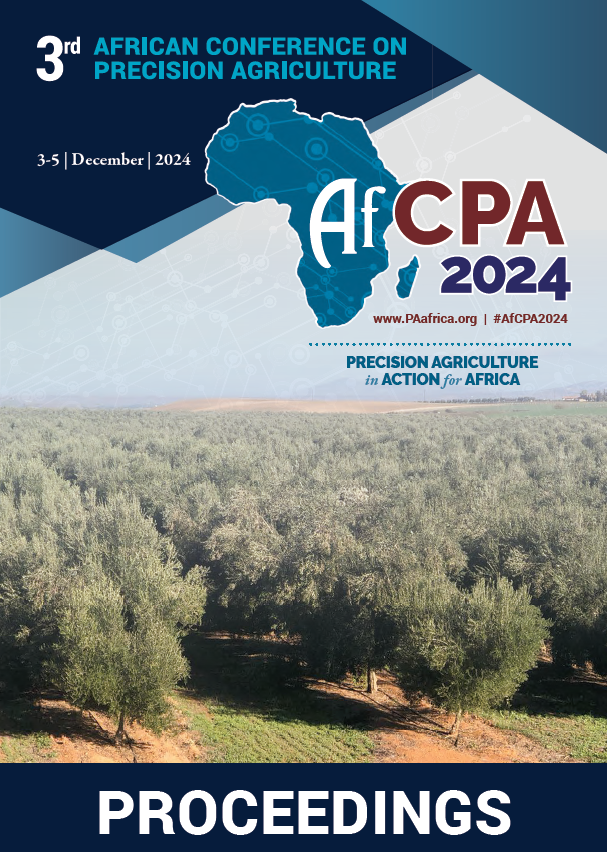Download the Conference Proceedings
Proceedings
Authors
| Filter results6 paper(s) found. |
|---|
1. La fertilité indigène du sol : un élément catalyseur de l’agriculture de précisionDans le contexte actuel de la dégradation des ressources naturelles et des problèmes de disponibilité et d'accessibilité des intrants agricoles, l'agriculture de précision dont le point d'entrée est la connaissance de la fertilité endogène du sol s'impose. Des essais soustractifs ont été conduits pendant deux ans (2018-2019) à la Station d'Expérimentations Agronomiques de l'Université... K. William, J. Sogbedji, M. Lare |
2. Self-developed Small Robot for Tomato Plants DetectionA mobile (robot) measuring station for tomato plant detection has been developed, equipped with different sensors and a self-developed hardware and software background. The development aims are the applications in precision crop production: artificial intelligence- based detection, imaging, data collection, automation, and remote sensing. The robot is fault- free in field conditions and is therefore a key development tool for precision farming and digital agriculture. The measurement system developed... B. Ambrus, G. Teschner, M. Neményi, A. Nyéki |
3. Unmanned Aerial Vehicles (UAVs) for Phenotypic Traits Estimation & Yellow Rust Disease Severity Assessment in Small-scale Wheat Breeding Trials in EthiopiaRemote Sensing (RS) platforms; like the Unmanned Aerial Vehicles (UAVs) are recently gaining traction in agricultural data collection systems and used for various phenotyping of breeding field trials and capturing different biophysical, biochemical and sanitary traits which can be used to predict and explain the resulting yield and selecting better verities. Compared to the conventional phenotyping usually done by visual scoring and manual measurements which is time consuming/back breakings, susceptible... T. Anberbir, G. Mamo , A. Dabi |
4. Variability in Yield Response of Maize to N, P and K Fertilization Towards Site-specific Nutrient Recommendations in Two Maize Belts in TogoLes régions de savane et du centre sont les principales zones de production de maïs au Togo, mais avec des rendements en grains de maïs à un seuil de seulement 1,5 Mg ha -1 . Nous utilisons une approche participative pour évaluer l'importance des trois principaux macro-éléments (N, P et K) pour la culture du maïs dans les deux régions afin de permettre davantage de recommandations d'engrais spécifiques au site et... J. Sogbedji, M. Lare |
5. Maximisation De L’efficience D’utilisation Des Nutriments : Recommandation De Fertilisation à La Carte Pour Le Maïs Sur Les Ferralsols Du Sud-togoL'amélioration de la nutrition des plantes à travers l'agriculture de précision devient incontournable pour l'optimisation de l'entreprise agricole et la protection de l'environnement. Nous avons conduit pendant la grande saison culturelle de 2019 et 2020, sous culture de maïs (Zea mays L.), des essais soustractifs à base de l'azote (N), du phosphore (P) et du potassium (K) à la station d'expérimentations agronomiques (SEAL)... J. Sogbedji, L. William, M. Lare, A. Sekaya, K. Sika , E. Tagba |
6. The Value and Potential of On-Farm Experimentation to Catalyze Agricultural TransformationOn-farm experimentation (OFE), which inculcates farmers’ agency in knowledge discovery, has the potential to support and accelerate transformative agronomy at scale. The OFE process within the Nutrient-Catalyzed Agricultural Transformation in Africa (NUTCAT) project, encompasses farmer engagements, set-up of simple, easy-to-understand treatment designs, and contextual analysis of the data to enhance the relevance of the results to farmers. Ultimately, it is envisaged that this process will... I. Adolwa, J. Muthamia, C. Lutomia, , S. Cook |
